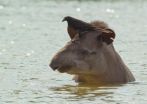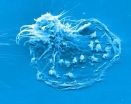(Press-News.org) Over 500 billion cells in our bodies will be replaced daily, yet natural selection has enabled us to develop defenses against the cellular mutations which could cause cancer. It is this relationship between evolution and the body's fight against cancer which is explored in a new special issue of the Open Access journal Evolutionary Applications.
"Cancer is far from a single well-defined disease which we can identify and eradicate," said Dr Athena Aktipis, Director, Human and Social Evolution, Center for Evolution and Cancer at the University of California, San Francisco. "It is highly diverse and evolutionary theory allows us to consider cancer as a highly complex and evolving ecosystem. This approach can improve the understanding, treatment and prevention of a number of different cancer types."
By applying the principles of evolutionary biology papers in the special issue ask: Why do we get cancer, despite the body's powerful cancer suppression mechanisms? How do evolutionary principles like natural selection, mutation, and genetic drift, work in a cancer ecosystem? How can we use evolutionary theory to minimize the rate of cancers worldwide?
"Nowhere is the diversity of cancer better revealed than the many reasons why we remain vulnerable to it," said Dr Aktipis. "Evolutionary medicine allows us to see explanations for traits that leave organisms vulnerable to disease."
These evolutionary explanations include the role of environmental factors, such as the relationship between tobacco availability and lung cancer; co-evolution with fast evolving pathogens; constraints on what selection can do; trade-offs, such as the capacity for tissue repair vs. risk of cancer; reproductive success at the expense of health; defenses with costs as well as benefits, such as inflammation.
"An evolutionary approach can unite and explain the many avenues of cancer research by allowing us to see cancer as an ecosystem," concluded Dr Aktipis. "Just as a forest depends on the individual characteristics of trees as well as the interactions of each tree with its environment; similarly tumors can be comprised of genetically distinct cells, which depend on both cell-to-cell interactions within the tumor, as well as on the interactions of tumor itself with the body."
###
This special issue is collaboration between scientists from the Darwinian Evolution of Cancer Consortium in France and the Center for Evolution and Cancer at the University of California, San Francisco. The issue is guest edited by Frederic Thomas, Michael Hochberg, Athena Aktipis, Carlo Maley and Ursula Hibner.
Papers from the Evolution and Cancer Special Issue are all freely available on the Evolutionary Applications website: www.evolutionaryapplications.org. END
How can evolutionary biology explain why we get cancer?
2013-01-22
ELSE PRESS RELEASES FROM THIS DATE:
Children with egg allergies can safely receive flu vaccine, U-M study says
2013-01-22
Ann Arbor, Mich. — Egg allergic children, including those with a history of anaphylaxis to egg, can safely receive a single dose of the seasonal influenza vaccine, according to a new study from the University of Michigan.
Historically, the CDC recommended that the seasonal influenza vaccine not be administered to egg allergic children. Recent research conducted at the University of Michigan, and elsewhere, helped modify this recommendation in 2011 so that caution was warranted for only those with severe egg allergy.
The new study, published in the Annals of Allergy, ...
Hypertension during pregnancy increases risk of end-stage renal disease
2013-01-22
Women with hypertensive disorders in pregnancy are at higher risk of chronic kidney disease and end-stage renal disease compared with women without the disorders, according to a study in CMAJ (Canadian Medical Association Journal).
"We found that women with hypertensive disorders during pregnancy were at higher risk of end-stage renal disease than women without complicated pregnancies," writes Dr. I-Kuan Wang, Division of Nephrology, China Medical University Hospital, Taichung, Taiwan, with coauthors.
Hypertensive disorders such as gestational hypertension and preeclampsia ...
Antibacterial agent used in common soaps found in increasing amounts in freshwater lakes
2013-01-22
When people wash their hands with antibacterial soap, most don't think about where the chemicals contained in that soap end up. University of Minnesota engineering researchers do.
A new University of Minnesota study determined that the common antibacterial agent, called triclosan, used in soaps and many other products is found in increasing amounts in several Minnesota freshwater lakes. The findings are directly linked to increased triclosan use over the past few decades.
In addition, the researchers found an increasing amount of other chemical compounds, called chlorinated ...
Paradise found for Latin America's largest land mammal
2013-01-22
NEW YORK (January 22, 2012) —Wildlife Conservation Society scientists have documented a thriving population of lowland tapirs – the strange forest and grassland-dwelling herbivore with the trunk-like snout – living in a network of remote national parks spanning the Peru-Bolivia border.
Using a combination of camera traps, along with interviews with park guards and subsistence hunters, WCS estimates at least 14,500 lowland tapirs in the region. The population bridges five connected national parks in northwest Bolivia and southeastern Peru.
The WCS findings were described ...
Immune system molecule with hidden talents
2013-01-22
This press release is available in German.
Dendritic cells, or DCs for short, perform a vital role for the immune system: They engulf pathogens, break them down into their component parts, and then display the pieces on their surface. This in turn signals other immune cells capable of recognizing these pieces to help kick-start their own default program for fighting off the invaders. In order to do their job, the DCs are dependent upon the support from a class of immune system molecules, which have never before been associated with dendritic cells: antibodies, best ...
New research on military traumatic brain injury
2013-01-22
Philadelphia, Pa. (January 22, 2013) – Researchers are making new strides in understanding the health consequences and treatment and rehabilitation needs of combat veterans and other service members affected by traumatic brain injury (TBI). The January-February issue of The Journal of Head Trauma Rehabilitation, official journal of the Brain Injury Association of America, is a special issue devoted to new research in military TBI. The journal is published by Lippincott Williams & Wilkins, a part of Wolters Kluwer Health.
"For the second consecutive year, we've expedited ...
New information on binding gold particles over metal oxide surfaces
2013-01-22
The strong binding of gold on electronically modified calcium oxide can now be understood in detail. In a computational study, researchers Jenni Andersin, Janne Nevalaita, Karoliina Honkala and Hannu Häkkinen at the University of Jyväskylä Nanoscience Center have shown how redox chemistry entirely determines the adsorption strength of gold on the modified oxide where one metal atom is replaced with molybdenum. The study was funded by the Academy of Finland.
The research team applied the so-called Born-Haber cycle to analyse how different terms contribute to adsorption ...
The Nurse Practitioner marks 25th Annual Legislative Update
2013-01-22
Philadelphia, Pa. (January 22, 2013) – The most comprehensive review of new legal and regulatory issues affecting advanced nursing practice across the United States is now available in the "25th Annual Legislative Update," presented exclusively by The Nurse Practitioner: The American Journal of Primary Healthcare. The Nurse Practitioner is published by Lippincott Williams & Wilkins, a part of Wolters Kluwer Health.
Compiled by Susanne J. Phillips, MSN, FNP-BC, the annual supplement presents a comprehensive review of the legislative proceedings, bills, and laws pertaining ...
South Americans want policy makers to put ethics above price
2013-01-22
Researchers at Royal Holloway university have found that Brazilians and Chileans want the state to buy on social and environmental criteria, not just on price.
Based on this pioneering research, researchers from Royal Holloway have been invited to be the first academics to join the UN Environmental Programme's global Sustainable Public Procurement Initiative and attend its meeting in Paris this week.
The Choices Project is a collaboration between Royal Holloway, the Universidade Federal do Rio de Janeiro and Universidad Diego Portales. The project team also involves ...
Mayo Clinic expert suggests proper techniques for newborn bathing and skin care basics
2013-01-22
ROCHESTER, Minn. -- Bathing a tiny newborn can be an exciting experience for parents, but it can also be intimidating. Newborns are small and vulnerable, slippery when wet, and the products marketed for their delicate skin can leave parents with abundant choices. As newborns are welcomed into the world, their skin needs to adapt to the new environmental changes around them. It's important for parents to understand proper bathing techniques and the appropriate skin care needed for their little one.
Pediatric dermatologist Dawn Davis, M.D., of Mayo Clinic Children's Center ...



